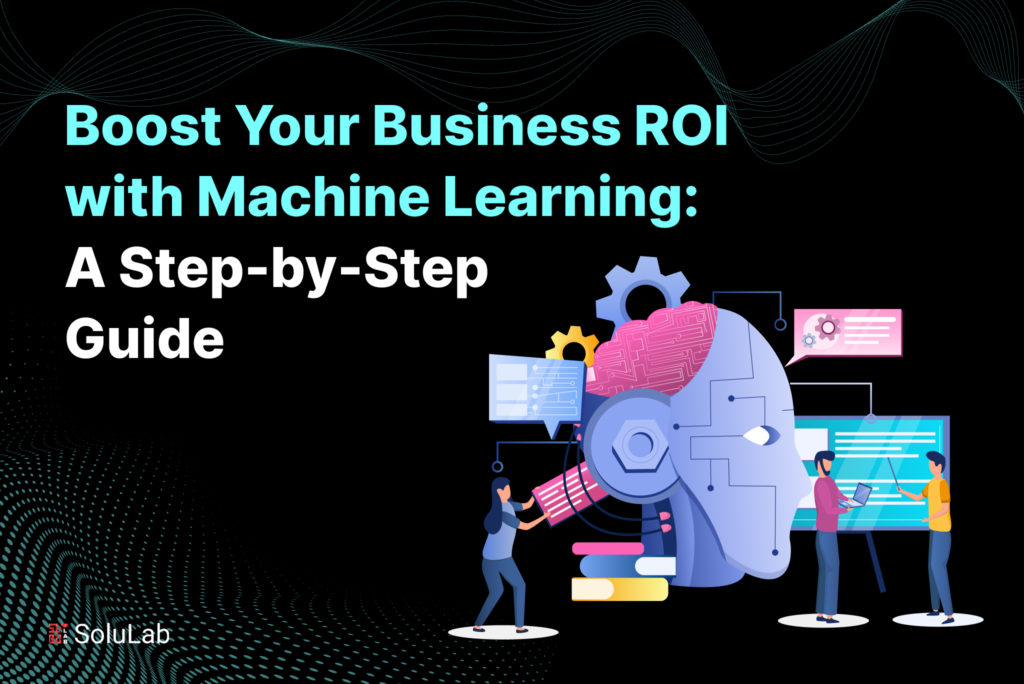
Return on Investment (ROI) is the bedrock of sound financial decision-making in the business world. Simply put, ROI measures the profitability of investments by evaluating the return, typically in monetary terms, generated from a specific investment relative to its cost. ROI is expressed as a percentage and is a powerful metric for assessing the effectiveness of various strategies, projects, or initiatives.
ROI = (Net Profit / Investment Cost) x 100
Understanding ROI is crucial because it provides valuable insights into the success or failure of investments. A positive ROI indicates that an investment has generated more revenue than its initial cost, while a negative ROI suggests the opposite. In essence, ROI with machine learning guides businesses in allocating resources wisely, ensuring that investments contribute positively to the bottom line.
Importance of Maximizing ROI
In the fiercely competitive business landscape, the efficient allocation of resources is paramount. Maximizing ROI is the key to achieving this efficiency. When businesses prioritize projects or initiatives with higher ROI potential, they ensure that every dollar invested has the potential to yield the greatest return. This, in turn, leads to increased profitability and sustainable growth.
Maximizing ROI offers several significant advantages:
- Resource Optimization: Businesses can allocate resources such as time, capital, and manpower more effectively by focusing on initiatives with higher ROI.
- Risk Mitigation: By analyzing the potential ROI of an investment, businesses can assess and mitigate risks associated with each opportunity.
- Decision Clarity: ROI provides a clear and objective basis for decision-making, allowing stakeholders to evaluate projects objectively.
- Sustainable Growth: Consistently optimizing the best ROI business ensures long-term growth and sustainability.
Machine Learning’s Role
Machine learning, a subset of Artificial Intelligence, has emerged as a transformative technology in recent years. Its ability to analyze vast datasets, recognize patterns, and make predictions has made it a game-changer across various industries. Now, businesses are harnessing the power of machine learning to boost Business ROI with Machine Learning.
Machine learning enables businesses to make data-driven decisions, optimize operations, and predict market trends accurately. It has the potential to significantly impact ROI by automating processes, improving customer experiences, and identifying new revenue streams.
Read Our Blog: Benefits of Machine Learning in Business
Understanding Machine Learning
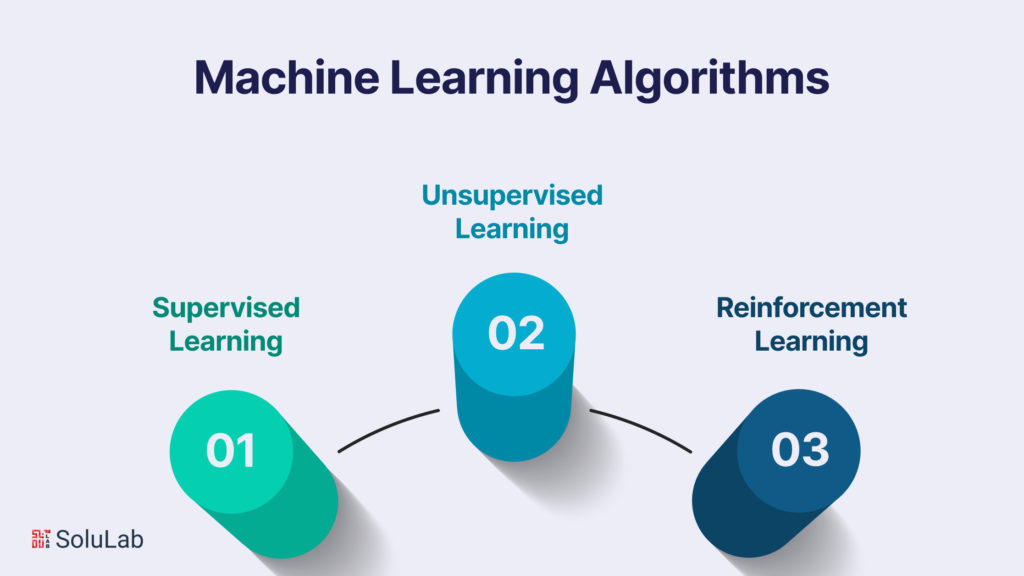
Machine learning is a branch of artificial intelligence (AI) that focuses on developing algorithms and models that allow computers to learn from data. Unlike traditional programming, where explicit instructions are provided, machine learning algorithms learn patterns and make predictions or decisions based on data inputs. This ability to learn from data is what makes machine learning so powerful and versatile.
Machine learning algorithms can be broadly categorized into three types:
- Supervised Learning: In supervised learning, algorithms are trained on labeled data, where the correct output is provided. The algorithm learns to make predictions based on this labeled data.
- Unsupervised Learning: Unsupervised learning algorithms work with unlabeled data and aim to find patterns, clusters, or relationships within the data without explicit guidance.
- Reinforcement Learning: Reinforcement learning involves training algorithms to make sequential decisions by interacting with an environment. The algorithm learns through trial and error, receiving rewards for good decisions and penalties for poor ones.
Read Also: Top 4 Machine Learning Use cases in the Healthcare Industry
Machine Learning’s Applications in Business
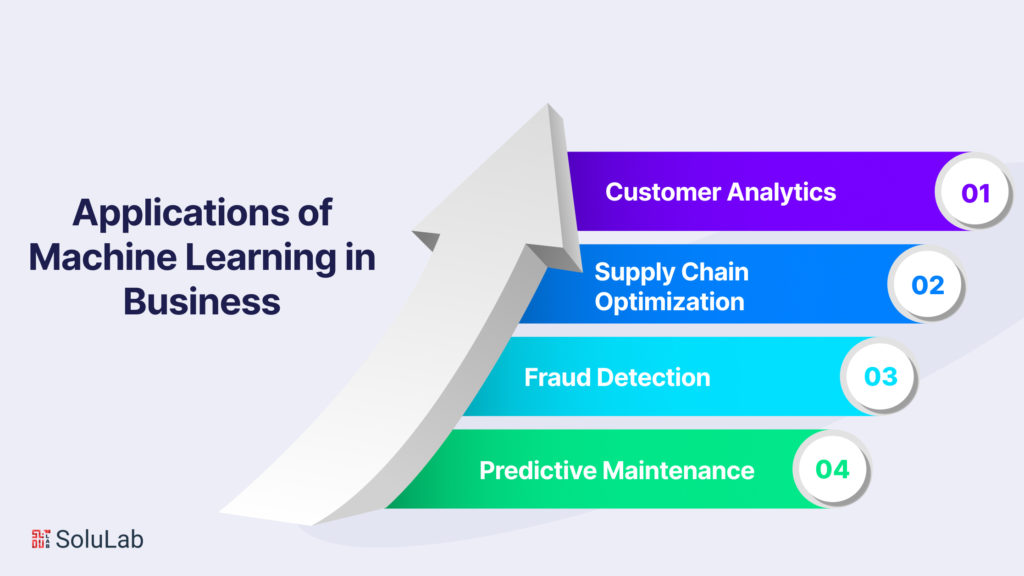
Machine learning’s applications in business are wide-ranging and impactful. Here are a few examples:
- Customer Analytics: Machine learning helps businesses understand customer behavior, predict preferences, and personalize marketing strategies.
- Supply Chain Optimization: Machine learning can optimize supply chain operations by predicting demand, reducing inventory costs, and enhancing logistics.
- Fraud Detection: Financial institutions employ machine learning to detect fraudulent transactions in real-time, protecting both customers and the institution.
- Predictive Maintenance: Industries such as manufacturing and aviation use machine learning to predict when equipment needs maintenance, reducing downtime and costs.
Data Gathering and Preprocessing
Before delving into machine learning models and strategies, it’s imperative to recognize that the quality of your data is the linchpin of success. The old adage “garbage in, garbage out” aptly applies here. In the context of machine learning, this means that the accuracy and effectiveness of your models are directly linked to the quality of the data they’re trained on.
High-quality data is:
- Accurate: Data should be free from errors, duplications, and inconsistencies. Accuracy ensures the reliability of the insights generated by machine learning models.
- Relevant: Data should be directly related to the problem you’re trying to solve. Extraneous or irrelevant data can introduce noise and hinder model performance.
- Complete: Missing data can be a significant roadblock. Completeness ensures that all necessary information is available for analysis.
- Consistent: Data should be structured uniformly to facilitate analysis. Consistency across data sources is essential for drawing meaningful conclusions.
Check Our Blog Post: 4 Machine Learning Use Cases in the Automotive Sector
Collecting and Preparing Data
- Data Collection: The process of collecting data can vary widely depending on your business and industry. It might involve customer surveys, sensor data, website logs, or any other relevant sources. It’s crucial to establish a robust data collection process to ensure a consistent inflow of data.
- Data Preprocessing: Once data is collected, it often requires preprocessing. This involves cleaning, transforming, and structuring the data to make it suitable for machine learning. Common preprocessing steps include handling missing values, dealing with outliers, and encoding categorical variables.
- Feature Engineering: Feature engineering is the process of creating new features or selecting relevant ones to improve model performance. This step can significantly impact the success of your machine-learning project. For instance, in a retail setting, you might engineer features like customer purchase history or seasonal trends to enhance sales predictions.
Data Quality
The emphasis on data quality cannot be overstated. In machine learning, even state-of-the-art algorithms can only work with the data they’re given. Thus, meticulous data gathering and preprocessing set the stage for success. Without a solid foundation of clean, relevant, and complete data, the subsequent steps in your machine-learning journey will be compromised.
Moreover, it’s crucial to understand that data quality is an ongoing concern. As your business evolves, so do the data requirements. Regularly monitoring and maintaining data quality ensures that your machine-learning models continue to provide reliable results.
Data quality assurance involves not only addressing issues in historical data but also establishing processes to maintain data quality in the future. This may involve data governance frameworks, data validation checks, and data stewardship roles within your organization.
By placing data quality at the forefront of your machine learning initiatives, you set the stage for accurate, actionable insights that can drive ROI optimization.
Read Our Blog: What is Machine Learning Image Recognition in Retail?
Choosing the Right Machine Learning Model
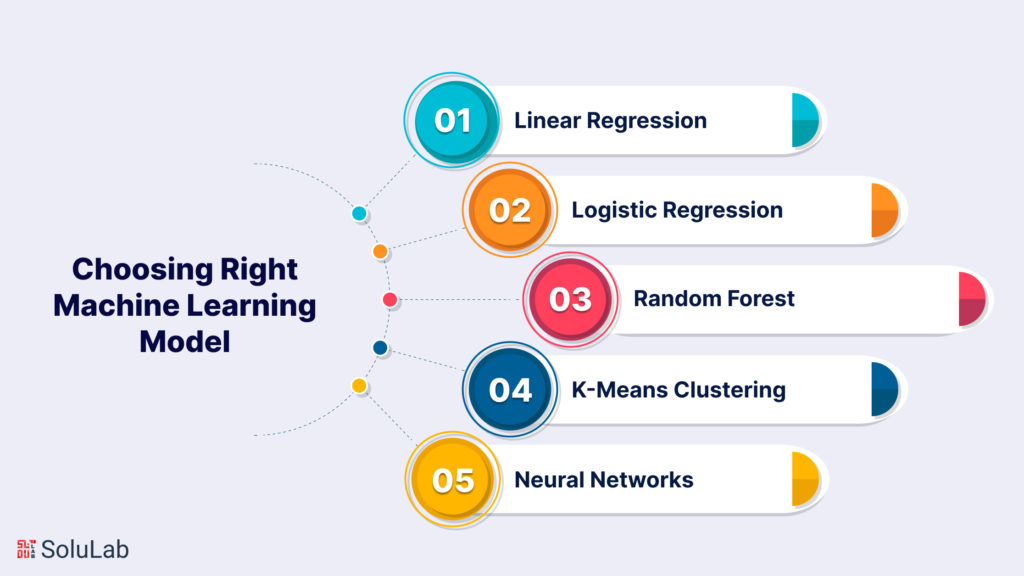
Now that we’ve laid the groundwork with high-quality data, let’s turn our attention to machine learning algorithms. These algorithms are the workhorses of predictive analytics and are used to make sense of data and generate valuable insights. There are various machine learning algorithms, each suited to different types of tasks.
Some of the most common machine learning algorithms include:
- Linear Regression: This algorithm is used for predicting continuous numeric values, making it suitable for tasks like sales forecasting or price prediction.
- Logistic Regression: Logistic regression is employed for binary classification problems, such as customer churn prediction.
- Random Forest: A powerful ensemble learning technique, Random Forest is useful for both classification and regression tasks and is known for its robustness and accuracy.
- K-Means Clustering: This unsupervised learning algorithm is used for grouping similar data points together, making it valuable for customer segmentation or anomaly detection.
- Neural Networks: Deep learning neural networks, including convolutional neural networks (CNNs) and recurrent neural networks (RNNs), excel in tasks like image recognition and natural language processing.
Selecting the Appropriate Model
The choice of machine learning model should align with your specific ROI optimization goal. For instance:
- Regression Models: If your goal is to predict a numeric value, such as estimating the lifetime value of a customer or forecasting product demand, regression models like linear regression or random forest regression might be suitable.
- Classification Models: For tasks like customer churn prediction or fraud detection, where the goal is to classify data into different categories, algorithms like logistic regression or decision trees can be effective.
- Clustering Models: If you aim to segment your customer base for targeted marketing, K-means clustering or hierarchical clustering can be instrumental.
- Deep Learning Models: In scenarios where data is unstructured, such as image analysis or natural language processing, deep learning models like convolutional neural networks (CNNs) and recurrent neural networks (RNNs) offer state-of-the-art solutions.
Read Also: Top 10 ICOs with the Best ROI
Complexity vs. Interpretability
Choosing the right model also involves considering the trade-offs between model complexity and interpretability. Some models, like deep neural networks, are highly complex and often described as “black boxes” because it’s challenging to understand how they arrive at their predictions. While they can achieve remarkable accuracy, they may lack transparency, which can be a concern in regulated industries or situations where interpretability is essential.
On the other hand, simpler models like linear regression or decision trees are more interpretable. You can readily examine the model’s coefficients or decision rules to understand why a specific prediction was made. However, they may not capture complex relationships in the data as effectively as more complex models.
The choice between model complexity and interpretability should be guided by your business’s needs and regulatory requirements. Sometimes, a hybrid approach, combining the strengths of different models, is the optimal solution.
Training and Testing the Model
With quality data in hand and a clear understanding of the machine learning model to use, the next crucial step is training the model. This is where the magic happens as the algorithm learns from the data to make predictions or decisions.
- Training Data: To train a machine learning model, you need a dataset that includes both input features and corresponding target values. The algorithm learns from this historical data, identifying patterns and relationships.
- Model Learning: During training, the model adjusts its internal parameters to minimize the difference between its predictions and the actual target values. This process is known as optimization or learning.
- Generalization: The ultimate goal of training is for the model to generalize well to new, unseen data. In other words, it should make accurate predictions on data it hasn’t encountered before.
Data Splitting
To ensure that the trained model generalizes well, it’s essential to split your dataset into two distinct subsets:
- Training Set: This portion of the data, typically around 70-80% of the dataset, is used to train the machine learning model. The model learns patterns and relationships from this data.
- Testing Set: The remaining 20-30% of the data is reserved for testing. The model has not seen this data during training. It is used to assess the model’s performance and evaluate how well it generalizes to new, unseen data.
The separation between the training and testing sets is crucial to avoid a common pitfall known as overfitting. Overfitting occurs when a model learns the training data too well, capturing noise and random variations rather than genuine patterns. Such a model will perform poorly on new data because it has essentially memorized the training set.
Check Our Blog Post: How To Increase ROI Through Food Ordering And Delivering Apps?
Model Evaluation
Evaluating a machine learning model’s performance is a critical step in the process. Various evaluation metrics are used depending on the nature of the problem (classification, regression, etc.). Some commonly used metrics include:
- Classification Metrics: For tasks like customer churn prediction or fraud detection, metrics such as accuracy, precision, recall, F1-score, and ROC-AUC are valuable for assessing the model’s performance.
- Regression Metrics: In regression tasks, metrics like Mean Absolute Error (MAE), Mean Squared Error (MSE), Root Mean Squared Error (RMSE), and R-squared (R²) help gauge how well the model predicts numeric values.
During the evaluation phase, you may also employ techniques like cross-validation, which involves splitting the data into multiple subsets to obtain a more robust assessment of the model’s performance.
Model evaluation doesn’t stop at the initial training phase. It’s an ongoing process as your business evolves and the data landscape changes. Regularly re-evaluating and retraining your model ensures that it continues to provide accurate predictions, contributing to sustained ROI optimization.
Implementing the Model in Your Business
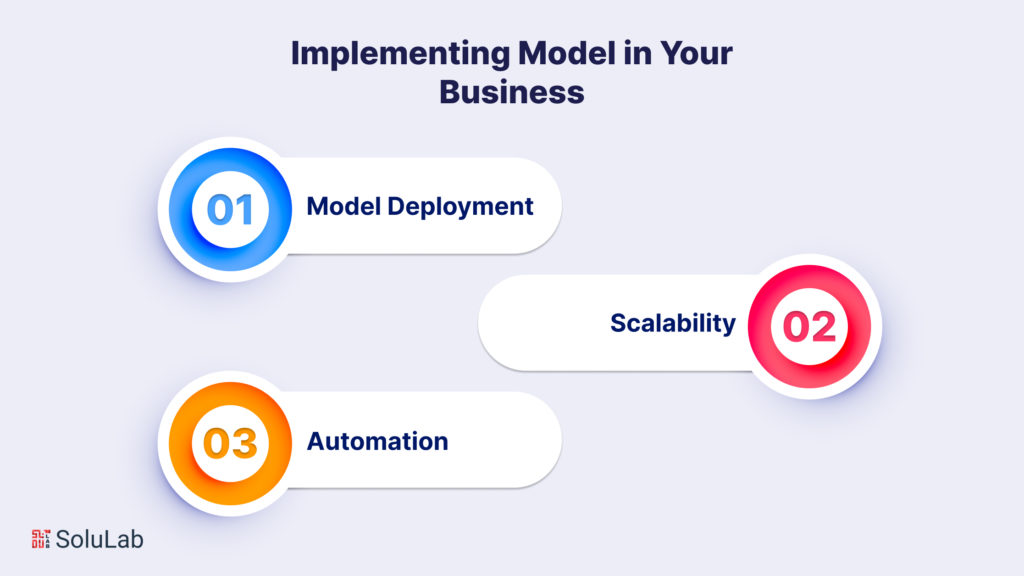
Once you have a well-trained machine learning model, the next challenge is seamlessly integrating it into your business operations. The implementation phase involves bridging the gap between data science and practical application.
- Model Deployment: Deploying a model means making it accessible for use in real-world scenarios. Depending on your business needs, deployment can take various forms, such as embedding the model into a mobile app, a website, or an existing software system.
- Scalability: Consider the scalability of your solution. Can the deployed model handle increased loads and growing datasets? Scalability ensures that your model can accommodate your business’s future needs.
- Automation: For maximum impact, strive for automation. Implement processes that enable your machine learning model to make real-time predictions or decisions without manual intervention.
Challenges and Solutions
The implementation phase often comes with its unique set of challenges:
- Data Drift: Over time, the distribution of incoming data may change, leading to data drift. This can negatively impact model performance. Implementing strategies to monitor and adapt to data drift is crucial.
- Model Monitoring: Continuously monitor the model’s performance in real-world scenarios. If it begins to underperform, have mechanisms in place to trigger retraining or alerts.
- Data Security and Privacy: Safeguard sensitive data used by the model, ensuring compliance with data protection regulations and minimizing the risk of breaches.
Addressing these challenges requires a combination of technical expertise, data governance, and collaboration between data scientists and business stakeholders.
Read Our Blog: How can Machine Learning improve the banking sector?
Real-time Decision-Making
One of the significant advantages of implementing machine learning models in business operations is the ability to make real-time decisions. Whether it’s personalizing product recommendations for online shoppers or optimizing inventory levels, real-time decision-making can lead to immediate improvements in ROI.
Real-time decision-making powered by machine learning is a game-changer because it allows businesses to respond swiftly to changing conditions, adapt to customer preferences, and seize opportunities as they arise.
Continuous Monitoring
After deploying a machine learning model into your business operations, it’s crucial to recognize that the work is far from over. In fact, it’s just the beginning. The performance of your model in real-world scenarios needs ongoing, vigilant monitoring.
- Performance Metrics: Define key performance metrics specific to your business goals and monitor them regularly. These metrics could include accuracy, revenue generated, customer retention rates, or any other relevant KPIs.
- Anomaly Detection: Implement anomaly detection mechanisms to identify unusual patterns or deviations in model behavior. This can help catch issues early, preventing potential revenue loss or customer dissatisfaction.
- Feedback Loops: Establish feedback loops with the end-users or teams interacting with the model. Their insights and observations can provide valuable input for model improvement.
Fine-Tuning Strategies
As your machine learning model operates in the real world, you’ll likely encounter situations where its performance starts to degrade or deviate from your desired ROI optimization goals. In such cases, fine-tuning becomes essential.
- Retraining: Periodically retrain your machine learning model with updated data. This helps the model adapt to changing conditions and maintain accuracy.
- Hyperparameter Tuning: Fine-tune hyperparameters like learning rates or regularization strengths to optimize the model’s performance.
- Feature Engineering: Revisit feature engineering techniques to ensure that the model is working with the most relevant and predictive features.
- Algorithm Selection: In some cases, you may discover that a different machine learning algorithm or model architecture performs better as your business evolves. Be open to exploring alternative approaches.
- Ensemble Methods: Ensemble methods, which combine predictions from multiple models, can often lead to improved accuracy and robustness.
- Feedback Incorporation: Utilize feedback from end-users or domain experts to improve model predictions. This iterative feedback loop can uncover nuances that were not initially captured.
- Data Quality Control: Maintain data quality standards rigorously. Data drift, erroneous inputs, or changes in data sources can impact model performance. Implement processes to detect and address data issues promptly.
Read Also: The Place of Machine Learning and Artificial Intelligence in the Automotive Industry
Evolving Machine Learning Landscape

The world of machine learning is dynamic and ever-evolving. New algorithms, tools, and techniques emerge regularly. Staying up-to-date with the latest developments is crucial for maintaining the competitiveness and effectiveness of your machine learning initiatives.
- Continuous Learning: Encourage your data science and machine learning teams to engage in continuous learning. Attend conferences, workshops, and online courses to keep skills sharp and knowledge current.
- Experimentation: Be open to experimentation. Test new approaches and technologies to see if they can offer better ROI optimization solutions.
- Collaboration: Foster collaboration between data scientists, domain experts, and business stakeholders. The synergy of expertise from different domains can lead to innovative solutions.
- Ethical Considerations: Be aware of ethical considerations in machine learning, such as bias and fairness. Ensure that your models are not inadvertently perpetuating discrimination or inequity.
- Regulatory Compliance: Stay informed about evolving regulations related to data privacy and machine learning. Compliance with data protection laws is critical to avoid legal issues and maintain trust with customers.
Concluding Remarks
In summary, monitoring and fine-tuning your machine-learning model is not a one-time task but an ongoing process. By continually assessing and improving your model’s performance, you can ensure that it continues to contribute to ROI optimization and business success.
SoluLab is a leading software development company specializing in innovative technologies like machine learning. They help businesses harness data-driven insights to maximize profitability and make informed decisions, aligning perfectly with the principles outlined in the guide on boosting ROI using machine learning. SoluLab, with its extensive expertise in machine learning development services, is the trusted partner for enhancing ROI through cutting-edge solutions in the ever-evolving tech landscape.
Partner with SoluLab to leverage their machine learning capabilities and propel your business towards greater success.
FAQs
1. What is the primary role of machine learning in boosting ROI?
The primary role of machine learning in boosting ROI is to leverage data-driven insights and predictive analytics to optimize business processes. Machine learning models can analyze large datasets, identify patterns, and make accurate predictions, which enables businesses to allocate resources more efficiently, make informed decisions, and identify new revenue opportunities.
2. How do I ensure the quality of data for my machine learning project?
Ensuring data quality is paramount for a successful machine learning project. To achieve this, establish data collection processes that minimize errors, validate data for accuracy, and address missing values. Regularly perform data cleaning and preprocessing to maintain data integrity. Additionally, implement data governance practices to uphold data quality standards over time.
3. What is the significance of model evaluation in machine learning for ROI optimization?
Model evaluation is critical because it assesses how well your machine-learning model performs in real-world scenarios. It provides an objective measure of accuracy and helps identify potential issues like overfitting. Accurate model evaluation ensures that the predictions made by the model contribute positively to ROI optimization, guiding business decisions effectively.
4. How can businesses adapt machine learning models to changing conditions?
Businesses can adapt machine learning models to changing conditions through continuous monitoring and fine-tuning. Regularly retrain models with updated data to keep them aligned with evolving trends. Implement strategies such as hyperparameter tuning, feature engineering, and feedback loops to improve model performance. Be agile in responding to data drift and emerging challenges.
5. What ethical considerations should businesses be aware of when using machine learning for ROI optimization?
Businesses should be vigilant about ethical considerations in machine learning. Avoid bias in data and models that could lead to discriminatory outcomes. Ensure transparency in model predictions, especially in regulated industries. Safeguard customer privacy and comply with data protection laws. Ethical machine learning practices not only protect the business from reputational risks but also uphold trust with customers and stakeholders.






